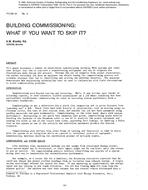Click here to purchase
As an emerging energy-efficient ventilation system, a highvolume, low-speed (HVLS) fan system is considered an effective means of cutting down energy consumption and building operation cost. This study adopts an engineered performance-based approach with the aid of a computational fluid dynamics (CFD) modeling tool to evaluate the potential fire hazard posed by this innovative technology. A systematic study is performed to find what types of fire hazards can be caused by a HVLS fan system and how such a fan system may adversely affect the functionality of fire detection systems and smoke spread at the early stage of a fire in a large space. It demonstrates that energy-saving HVLS fans may cause delay in fire detection and aggravate smoke spread and therefore expose occupants to a hazardous environment. It is expected that amendments in future editions of building codes and standards will address fire life safety risks posed by HVLS fan systems and provide regulations and guidelines for the design and installation of these systems.
Citation: 2019 Annual Conference, Kansas City, MO, Technical Papers
Product Details
- Published:
- 2019
- Number of Pages:
- 17
- Units of Measure:
- Dual
- File Size:
- 1 file , 11 MB
- Product Code(s):
- D-KC-19-003


